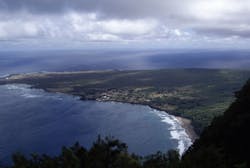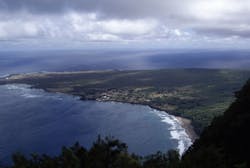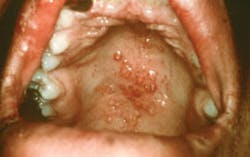Leprosy: Hansen's Disease
by Nancy W. Burkhart, BSDH, EDD
Of all the Hawaiian islands, Maui is my favorite place to be while on vacation. I have been to the island many times and go back whenever the opportunity arises. When my husband was in the U.S. Navy, we were stationed at Pearl Harbor on Oahu, and we fell in love with the Hawaiian Islands. A neighbor in Honolulu was from Molokai (the fifth largest island), and we frequently heard stories about the island.
Although I had not been to Molokai on any previous visits, I decided to make a trip by boat while visiting Maui recently. While there, I learned more about the settlement at Kalaupapa that has been home since 1866 to those afflicted with leprosy (see Figure 1). The settlement is geographically isolated, and I actually viewed it from a high cliff in Molokai. As you can see, the settlement is on a beautiful area of Molokai's Makanalua peninsula known as Kalaupapa (Ka-lau'-pah'-pa).
A Place of Isolation
The settlement is reachable by small aircraft, boats, and a donkey ride that goes down the mountainside. The native guide for my tour was very informed about the colony, the hardships of its people, and the work of Father Damien, a Catholic priest who arrived at the settlement in 1873. His work and compassion caused progress to occur at Kalaupapa for those afflicted with leprosy. Father Damien has obtained sainthood and his legacy is still very strong within the people of Molokai.
------------------------------------------------------------
Other articles by Burkhart:
- Is it an oral cancer exam or screening?
- Oral Lichen Planus And Coping With Stress
- Do you remember the glands of Blandin and Nuhn?
------------------------------------------------------------
In the past years, some 8,000 individuals have been sent to the settlement and they are cared for by nurses, nuns, and doctors. The numbers have become small at this point since the introduction of medications available to cure leprosy, but some residents with past histories of leprosy still remain at Kalaupapa settlement. Some residents have spent entire lives at this settlement after arriving as children. Although they have been cured, they do not leave the settlement because of the effects from the disease such as body deformity and disabilities.
Psychologically, the lack of support from the outside world and the security of friends within the settlement have caused them to view the settlement as a safe, supportive refuge from the outside world. There is a strong stigma associated with the disease even today. The World Health Organization lists the failure to completely eradicate the disease from the world because of this stigma and the failure to self-report symptoms in some communities. The term "lepers" dehumanizes the person, and biblical images such as "unclean" and "moral outcast" may still be attached to the disease. Leprosy has been reported and feared in ancient civilizations such as Egypt, India, and China. Leprosy in the Hawaiian Islands may be documented as early as the 1830s.
The Stigma Attached to Leprosy
Published accounts of individuals and whole families of Kalaupapa exist, expressing the sadness and isolation that has been suffered by these patients throughout the years. Ted Gugelyk and Milton Bloombaum from the University of Hawaii conducted in-depth interviews in a qualitative study on the residents as part of a research project. The accounts of these patients relay the frightening experiences of a disease with no known cure for many years and the lack of social support that existed from the outside community. Accounts of children taken from their families, babies born in the settlement but removed and sent to families in Honolulu before they could be exposed to the Mycobacterium leprae are documented in these interviews.
Children are deemed more susceptible to leprosy because of their immature immune systems. Mycobacterium leprae is a member of the same family of organisms found to cause tuberculosis. Individuals known to have signs of leprosy anywhere in the islands were rounded up and taken to the Kalaupapa settlement. In the early years, boats were used to transport the suspected patients. A family history of the disease made any family member questionable, and fear of being sent to the settlement was paramount.
Through patients' accounts, it is known that some people were sent to the settlement who did not have the disease, but rather skin disorders. At one time, there was also a fee that was given for reporting "contacts" who may have had the disease. The people affected with the possibility of leprosy feared the Board of Health and the mandatory isolation. Some individuals actually stayed in hiding to escape the possibility of exile. Their own relatives abandoned many patients. In some cases, other family members even reported relatives to the authorities.
Today, Kalaupapa is voluntary, a cure for leprosy exists, and those still living in the facility will be taken care of as long as they wish to remain in the community or until death. The extended family (ohana) provides support to these people who may have lived their entire lives from early childhood within the settlement. The land (aina) is important to those left at Kalaupapa today, and there is a strong historical attachment to the peninsula. The area is now a national park, and when the last residents leave, there is speculation that the area will probably become more of a tourist area.
Pharmacological Agents
Leprosy is one of the least communicable of all infectious diseases with symptoms occurring within three to five years after contact, but signs of the disease may be delayed for as many as 20 years. G.A Hansen discovered the M. leprae bacillus in 1873. Leprosy is caused by a very slow growing acid fast, rod-shaped bacillus and is now treatable with multidrug therapy (MDT) since the 1960s. Early drugs of the sulfone family (dapsone) became available in the 1940s but patients reported side effects that were sometimes intolerable. Multi-drugs such as rifampicin and clofazimine were added to the regimen to kill the pathogen in later years.
Prior to the introduction of the MDT, a product called chaulmoogra oil was the only known "treatment" for the patients. Certain ethnic populations are more vulnerable to the disease (the Hawaiians, Japanese, and Chinese who lived on the islands). Today leprosy is found mainly in underdeveloped countries in Africa, Asia, Central and South America. In the United States, cases can be found in Texas, Louisiana, Florida, California, and Hawaii. The World Health Organization estimates approximately 182,000 cases world wide in 2012, with elimination of the disease in 119 countries out of 122 since 1985. However, new cases have recently been reported to have increased in India.
The disease affects multiple systems and organs of the body such as the nerves leading to muscle weakness, the liver, kidneys, eyes resulting in blindness, lymph nodes, bones, and joints. The bones are resorbed and deformity occurs. The residents of Kalaupapa mention in multiple interviews that the medications used in early treatment were sometimes worse than the actual disease Many of the patients would cease taking them because of the profound effects on the body.
Oral Manifestations
The oral manifestations of leprosy may be present in 19% to 60% of patients. Shambulingappa, et al. (2012) states that the oral examination is neglected in most leprosy clinics today. Figure 2 depicts the oral lesions-papules of a patient with leprosy.
When oral lesions appear, they usually occur in the LL form (disseminative and progressive lepromatous form). This form presents with the most severe effects on the body. The second form is the tuberculoid form (TT), and this form is less contagious. Combinations of both types may also occur. Oral lesions occur in the palate intraorally, but may manifest as skin lesions periorally affecting the lips. The lips present as macrocheilia and exhibit flat-topped nodules.
Diagnostically occurring lesions in the palate were suggestive of leprosy. A triad was noted as facies leprosa and occurred along the anterior nasal spine, palatal sutures, and alveolar process of the maxilla. Nasal congestion and stuffiness is a common problem with those afflicted because of the involvement of the nasal and oral membranes. Written accounts of patients report cotton swabs being placed deep into the nose with medication to dislodge nasal congestion. Nosebleeds were common. Fibrosis occurs leading to deformities and disfiguration.
Other oral lesions may occur causing superficial ulcers, candidiasis, fissured tongue, and loss of papillae, glossitis, and swellings. Treatments for leprosy include antibiotics, anti-inflammatory medications, steroids, thalidomide, or combinations of MRD therapy, depending upon the type and extent of the leprosy. Often, pain and ulceration are treated as other complications would be treated to relieve discomfort.
With the information I learned from my visit to Molokai, I could not help but realize that other disease states such as polio, typhoid, plague epidemics, and AIDS have resulted in the fear that populations exhibited when these disease states were discovered within families and communities. Communicable disease that offers no cure does promote a fear within our world. A better understanding of organisms, epidemics, and the spread of disease will allow swift research into cures and management of future disease states. Hopefully, history will be a lesson to all of us.
As always, continue to ask good questions and always listen to your patients.
NANCY W. BURKHART, BSDH, EdD, is an adjunct associate professor in the department of periodontics, Baylor College of Dentistry and the Texas A & M Health Science Center, Dallas. Dr. Burkhart is founder and cohost of the International Oral Lichen Planus Support Group (http://bcdwp.web.tamhsc.edu/iolpdallas/) and coauthor of General and Oral Pathology for the Dental Hygienist. She was a 2006 Crest/ADHA award winner. She is a 2012 Mentor of Distinction through Philips Oral Healthcare and PennWell Corp. Her website for seminars on mucosal diseases, oral cancer, and oral pathology topics is www.nancywburkhart.com.
References:
Gugelyk T, Bloombaum M. The separating sickness. 4th edition, 2005. Darnsutha Press, Bangkok, Thailand.
Shambulingappa P, Sheikh S, Kaur A, Aggarwal A, Singh R. Oral cavity and leprosy. Indian Dermatol Online J. 2012 May-Aug; 3(2):101-104.
World Health Organization Fact Sheet, 2013. http://www.who.int/mediacentre/factsheets/fs101/en/ Accessed 11-9-2013.
Wisniewski RA. Kalaupapa and the Legacy of Father Damien. Pacific Basin Enterprises, Honolulu Hi. 2007.
Past RDH Issues


